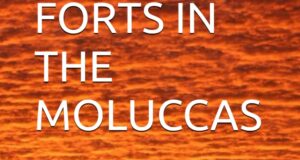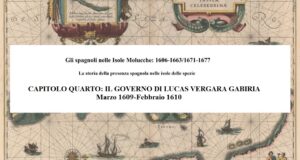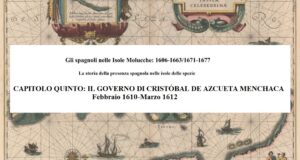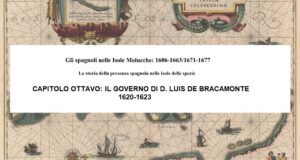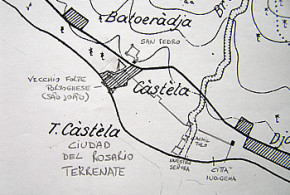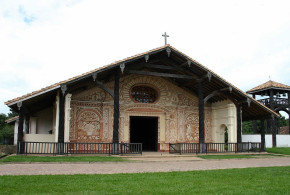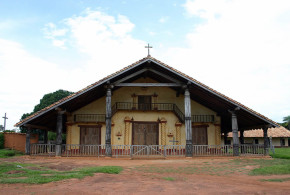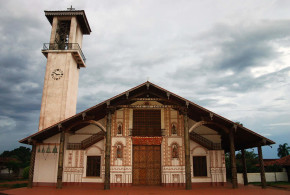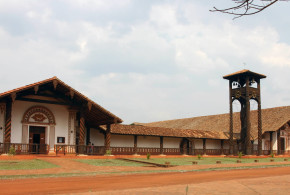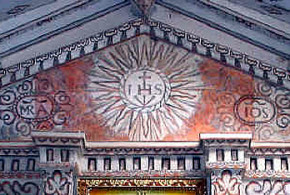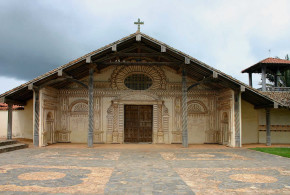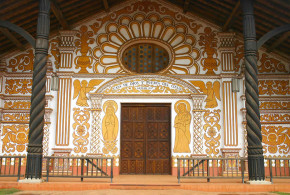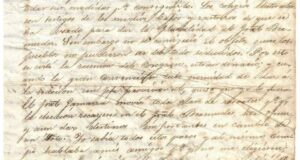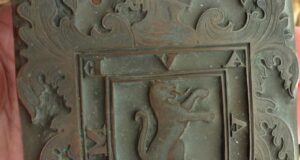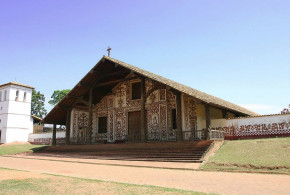This post is also available in:
![]() Italiano
Italiano
Written by Marco Ramerini 2000-2007/2023
5.4 – SOKANORA
Sokanora, Socanora1, Sokanosa, Saconora2, Zoconora3: (Current name: ?)
CHRONOLOGY: Spanish: 1613-c.1620 (?)
Socanora, was a village located on the coast to south of the city of the king of Tidore (‘Lugar Grande‘). Here the Spanish maintained a small fortified post for some years.
We already have a first mention of the village of Socanora in the collection of Navarrete, on the occasion of the expedition of Loaisa, Socanora (called ‘Zocoñora’) is described as a ‘pueblo‘ of the island of Tidore.4 Subsequently Socanora is also mentioned at the time of the Portuguese, in fact in the report on the loss of Tidore made by the Jesuit father Luis Fernandes in July 1605, a place called ‘Saconora‘ is mentioned. The place is mentioned not as a function of a fortress present there, but because it was the name of a tip of the island of Tidore where the Dutch ships were anchored ‘…as naus foram surgir em uma ponta da ilha que chamam Saconora…’5
After the Dutch conquest of Marieco (February 1613), the king of Tidore had the tip of Socanora fortified, perhaps recalling the episode of 1605, when the Dutch had anchored their fleet in Socanora before the attack led to the Portuguese fort. In February 1613 the Spanish sent the ensign Arrequibar with 8 soldiers to garrison the fort of Socanora, the fort is described as the most important fort that the king of Tidore owns it was located half a league from the king’s city. The king had placed an artillery piece in the fort and asked for powder for this cannon, which however the Spaniards could not provide.6
The possession of Socanora was important because it guaranteed the Spanish troops stationed in the city of Tidore connections with Ternate, as, in fact, the king of Tidore affirms in a letter written to Gerónimo de Silva, in 1613, during the great attack launched by the Dutch in Tidore: ‘si ellos ponen naos de la banda de Socanora no ha de poder entrar aquí socorro ninguno’.7
In addition to the importance for the connections with Ternate, Socanora was important because it could be a place to land troops and then be able to attack the king’s city from the south, this due to its proximity to the city of Tidore ‘…lugar de Socanora en la isla de Tidore, que es aun no media legua del lugar Grande de Tidore’.8 Socanora completed the defenses of the city, which was guarded to the north by the Portuguese fort and to the south by Socanora: ‘…otro lugar de esotra banda del Grande, que se llama Socanora, que entre este y el fuerte, que ganaron, está el lugar del rey…’, the fort of Socanora had been built in a strategic position on a hill overlooking the sea: ‘…este lugar, que está fundado en una eminencia cerca de la marina…’.9
In July 1613, the Dutch, returning from the conquest of the old Portuguese fort, decided on the wave of enthusiasm for this victory to also attack the new Spanish fort of Tahula, located on a hill in the southern part of the capital and which was still under construction. The Dutch embarked, in the middle of the night, all the soldiers on 3 ships (4 ships according to Spanish sources) and on 20 Ternatese ‘caracoas‘ (40-43 ‘caracoas grandes y chicas‘ according to Spanish sources) and moved to the vicinity of the hill on which the fort was located.
But here the Dutch ran into problems and were unable to disembark due to the wind and strong currents, which drove the ships further south in front of the fortified village (‘fuertecillo‘) of Sokanora, located about ½ mile (or half a league) south of the city and which had recently been abandoned by the small Spanish garrison, led by ensign Pedro de la Fuente Urroz. The small garrison of the fort had been recalled to the defense of Tidore and had recently left the garrison of the small fort in the hands of the villagers.
While some Dutch ships bombarded the town of Tidore to keep the defenders occupied and other attacks were simulated on the side of the Portuguese fort. The Dutch ships, led by Laurens Reaal, landed their troops at Socanora, 6 companies totaling more than 1000 men. The Dutch on July 11, 1613 (according to Spanish sources) in an attempt to make a way overland to the town of Tidore, attacked the village twice (three times according to Spanish sources).
During the first attack, the resistance of the king of Tidore’s men was almost overcome, but just as they were about to surrender, reinforcements arrived from Tidore commanded by the ensign Pedro de la Fuente who with 5 other Spanish soldiers and some Tidorese suddenly attacked the enemy troops (which it should be remembered were made up of more than 800 Dutch and over 1,500 Ternatese) for the rearguard. The Dutch, perhaps surprised by the attack and thinking they were being attacked by a large enemy force, panicked and fled, the Spaniards entered the fort and with the artillery repeatedly struck the enemies, killing and wounding many of them.
Thanks to this action and mainly due to the inexperience of the Dutch guides and commanders, the attackers had to retreat with heavy losses, 15-16 Dutch and 25 Ternatese were killed as well as many wounded. Even the Dutch sources state that the Spaniards and the Tidorese had already abandoned the village, but realizing that the attackers had gone the wrong way, they went back and attacked the Dutch who suffered heavy losses.
Subsequently, although it was the opinion of many to proceed towards the city of Tidore as agreed, the Ternatese proved confident of being able to conquer Socanora, so it was decided to attempt another attack on the village, which however, like the other one, ended in a colossal fiasco, also this time the Dutch and Ternatese took the wrong direction again and were attacked and decimated by the Spanish and Tidorese.
The attacks had followed one another from morning until night, the king of Tidore informs us, causing only one death and some injuries among the Tidorese. After the failures at Socanora, the Dutch returned to the old Portuguese fort where, on 13 July (12 according to Dutch sources), they made a last abortive attack on the city of Tidore. Two companies of soldiers were sent against the city, but the sight of a small force of just over 30 Tidorese led by the Prince of Tidore managed to put them to flight. The Dutch lost 24 soldiers and many weapons in this clash, Dutch sources speak of 11 dead on their side and 4 dead among the enemies including the third richest person in all of Tidore. Pieter Both blamed these repeated defeats of Dutch troops on the fact that the Dutch had used sailors as soldiers. In fact according to Both the sailors were good soldiers as long as things went well, but when obstacles arise they are easily demoralized.10
Most likely the miracle of St. Francis Xavier described by Father Colin in his book “Labor Evangelica” is to be linked to the episode of the battle of Socanora. Witness of the miraculous event is a Spanish soldier, who was in charge of a small fort ‘furtecillo‘ with a garrison of 14 Spanish soldiers, who learned that the Dutch and the Ternatese were preparing to attack it and being the small and indefensible fort faced with so many enemies, he decided together with his soldiers to meet the enemy troops in the open field. Realizing the desperate situation they were in, the soldier placed himself in the hands of the Lord through St. Francis Xavier. The clash began and in the bloodiest moment of the battle, some Spanish soldiers noticed a Jesuit who was driving away the Dutch from the walls of the small fort, according to the witness it was St. Francis Xavier, thanks to this miraculous intervention, the enemy troops were forced to flee.11
After withstanding the Dutch attack, the small fortification of Socanora continued to have a Spanish garrison. In mid-1616 there were over 200 Spanish soldiers garrisoning the forts of Tidore, i.e. in the forts of Santiago, del Príncipe, Tomanira and Socanora “…por las pocas fuerzas que hoy tiene el rey de Tidore, por ser muy solo y no tener en su isla lo que tenia hasta aqui, por lo que me conviene tener siempre en esta isla sobre ducientos hombres en la plaza de Santiago y en el fuerte del Principe, Tomanira y Socanora”.12 In 1618, during the second period of government of Vergara, who renewed many of the fortifications of the islands, the stronghold of Socanora in Tidore was among others fortified again. This happened because Socanora was located in a very strategic point, and which, because of this, had repeatedly suffered attacks by the Dutch.13 Subsequently there are no more mentions of Socanora, probably the Spanish garrison was withdrawn on the occasion of the abandonment of Marieco by the Dutch.
| Captains of Socanora | |
| Arrequibar14, ensign | February 1613- |
| Pedro de la Fuente Urroz15, ensign | 1613 |
| Pedro de la Fuente Urroz16 |
INDEX:
1 – The Spanish fortresses on the island of Tidore 1521-1663: introduction
3 – The Spanish expeditions to the Moluccas after the union with Portugal
4 – The Spanish forts of the island of Tidore 1606-1663
5 – The defenses of the city of the King of Tidore: Lugar Grande De El Rey (Soa Siu)
6 – Fuerte de los portugueses (Fortaleza dos Reis Magos)
7 – Tohula Fort, Santiago de los Caballeros
8 – Sokanora Fort
9 – Marieco Fort
10 – Tomanira Fort
11 – Chobo Fort
12 – Fort of Rume
13 – Puli Caballo Island
14 – Captains of Tidore (Fortress of Santiago de los Caballeros)
NOTES:
1 “Tanto de carta que el señor don Gerónimo de Silva escribió á el señor don Juan de Silva, Tidore, 8 de agosto 1616” In: Various authors “Correspondencia” 388
2 ‘Saconora’ is described as ‘ponta da ilha que chamam Saconora’. Doc. n° 179° “Fr. Luís Fernandes’ report on the loss of Tidore and his voyage to Cebu, Cebu July 1605” in: Jacobs, “Documenta Malucensia II, 1577-1606” 701
3 It is described as a pueblo of the island of Tidore. Fernanadez de Navarrete “Colección de los viajes, vol. 2” 115
4 “Derrotero del viage y navegacion de la armada de Loaisa…” document n°14 in: Fernanadez de Navarrete “Colección de los viajes, vol. 5” 298 Fernanadez de Navarrete “Colección de los viajes, vol. 2” 115
5 Doc. n° 179° “Fr. Luís Fernandes’ report on the loss of Tidore and his voyage to Cebu, Cebu July 1605” in: “Documenta Malucensia, I, 1577-1606I” 701
6 “Carta que escribió el sargento mayor don Fernando de Ayala […] á el señor don Gerónimo de Silva, Tidore, 16 de febrero de 1613” in: Various authors “Correspondencia” 90-91
7 “Carta que el rey de Tidore escribió á el gobernador don Gerónimo de Silva sobre la pérdida del fuerte de los portuguéses, 9 de jullio de 1613” In: “Correspondencia” 138
8 “Tanto de carta que el gobernador don Gerónimo de Silva escribió á el fiscal don Juan de Alvarado y Bracamonte. Terrenate, á 27 de jullio de 1613” In: AA.VV. “Correspondencia” 155
9 “Tanto de carta que el señor don Gerónimo de Silva escribió á el Rey nuestro señor. Terrenate, 3 jullio de 1614” In: Various authors “Correspondencia” 230
10 Rietbergen, P. J. A. N. “De eerste landvoogd Pieter Both, 1568-1615” Vol. I, 100-101; Vol. II “Verhaal Both” 349-352 e “Brief 15” 284-286
Several letters in Geronimo de Silva’s “Corrispondencia” speak of the clashes that took place in Socanora: Various authors “Correspondencia” 138-179
Colenbrander, H. T. “Jan Pietersz Coen. Bescheiden omtrent zijn bedrijf in Indië” “Aanval op Tidore”16-21
Wessels “De katholieke missie in de Molukken, Noord Celebes en de Sangihe eilanden. Gedurende de spaansche bestuursperiode, 1606-1677” 50-51
Pérez, Lorenzo O.F.M. “Historia de las misiones de los Franciscanos en las islas Malucas y Célebes” In: “Archivum Franciscanum Historicum” VII (1914) 221-222
“Informaciones: Pedro de la Fuente Urroz. Informaciones de oficio y parte: Pedro de la Fuente Urroz, capitán, vecino de Manila. Informaciones y poder. [f] 1632” AGI: Filipinas,61,N.12
“Confirmación de encomienda de Agoo. Expediente de confirmación de la encomienda de Agoo en Pangasinan a Pedro de la Fuente Uriez (sic por Urroz). Resuelto. [f] 28-09-1630” AGI: Filipinas,48,N.39
11 Colin-Pastells “Labor Evangelica, vol. III” 569
12 Rios Coronel, Hernando de los “Memorial y relacion…” (1621, Madrid) In: Blair, E. H. e Robertson, J. A. “The Philippine Islands, 1493-1898” vol. 19 (1620-1621), 214 “Extract from Gerónimo de Silva’s letter to Governor D. Juan de Silva, July 29, 1616” see alsoe: “Tanto de carta que el señor don Gerónimo de Silva escribió á el señor don Juan de Silva, Tidore, 8 de agosto 1616” In: Various authors “Correspondencia” 387-388
13 “Letter by Fajardo to the King Felipe III, 10 August 1618” in Blair vol. 18 pp. 137-140 where the letter of the Jesuit Manuel Ribeyra is reported, also reported in “Fr. Manuel Ribeiro to governor Alonso Fajardo de Tenza. Cavite, 10 August 1618” in: Jacobs, H. “Documenta Malucensia III, 1606-1682” Doc. n° 106, 375-378.
“Carta de Manuel Ribeiro a Fajardo de Tenza sobre Terrenate, 10-08-1618” AGI: Filipinas,7,R.5,N.54
14 “Carta que escribió el sargento mayor don Fernando de Ayala […] á el señor don Gerónimo de Silva, Tidore, 16 de febrero de 1613” in: Various authors “Correspondencia” 90-91
15 Pedro de la Fuente Urroz, was in charge of the fort shortly before the Dutch attack of July 1613 (the date 1614 is reported in the document, certainly an error by the copyist for 1613), then following the Dutch attack on Tidore, the order to leave the garrison of the fort in the hands of the villagers and to return to Tidore with the small garrison, the Spanish document says that, having learned of it, the Dutch attacked Socanora with 4 war galleons, 43 boats from Ternate and a boat of Japanese. The enemies besieged the fort, which was defended by the men of the king of Tidore and who were almost on the verge of surrendering when Pedro de la Fuente was again sent from Tidore with 5 other Spanish soldiers and some Tidorese. The small Spanish contingent suddenly attacked the enemy troops (which were made up of more than 800 Dutch and over 1,500 Ternatese) for the rearguard, the enemy troops perhaps surprised by the attack fled, the Spaniards entered the fort and with the artillery repeatedly hit the enemy, killing and wounding many. The Dutch tried three times to take the fortification, but the Spanish always managed to push them back. After this fight the Dutch embarked in their ships and abandoned Socanora. This victory was decisive for the defense of the island of Tidore, because Socanora was the key to the island. “Informaciones: Pedro de la Fuente Urroz. Informaciones de oficio y parte: Pedro de la Fuente Urroz, capitán, vecino de Manila. Informaciones y poder. [f] 1632” AGI: Filipinas,61,N.12
“Confirmación de encomienda de Agoo. Expediente de confirmación de la encomienda de Agoo en Pangasinan a Pedro de la Fuente Uriez (sic por Urroz). Resuelto. [f] 28-09-1630” AGI: Filipinas,48,N.39
16 Pedro de la Fuente Urroz, on the orders of Geronimo de Silva was again for the second time head of Socanora. “Informaciones: Pedro de la Fuente Urroz. Informaciones de oficio y parte: Pedro de la Fuente Urroz, capitán, vecino de Manila. Informaciones y poder. [f] 1632” AGI: Filipinas,61,N.12
“Confirmación de encomienda de Agoo. Expediente de confirmación de la encomienda de Agoo en Pangasinan a Pedro de la Fuente Uriez (sic por Urroz). Resuelto. [f] 28-09-1630” AGI: Filipinas,48,N.39
This post is also available in:
![]() Italiano
Italiano
 Colonial Voyage The website dedicated to the Colonial History
Colonial Voyage The website dedicated to the Colonial History


